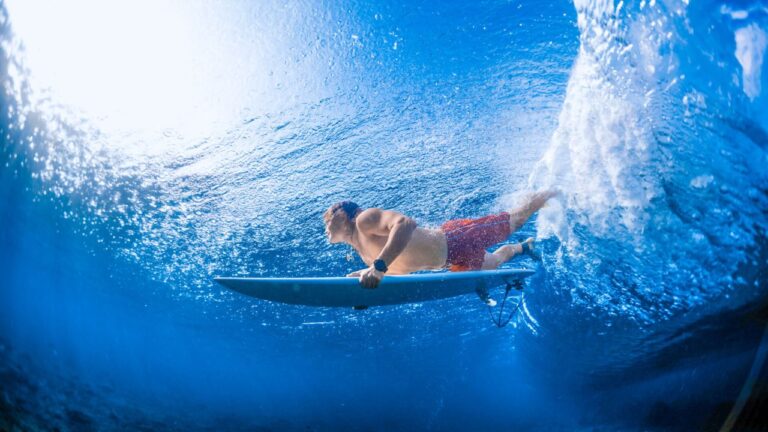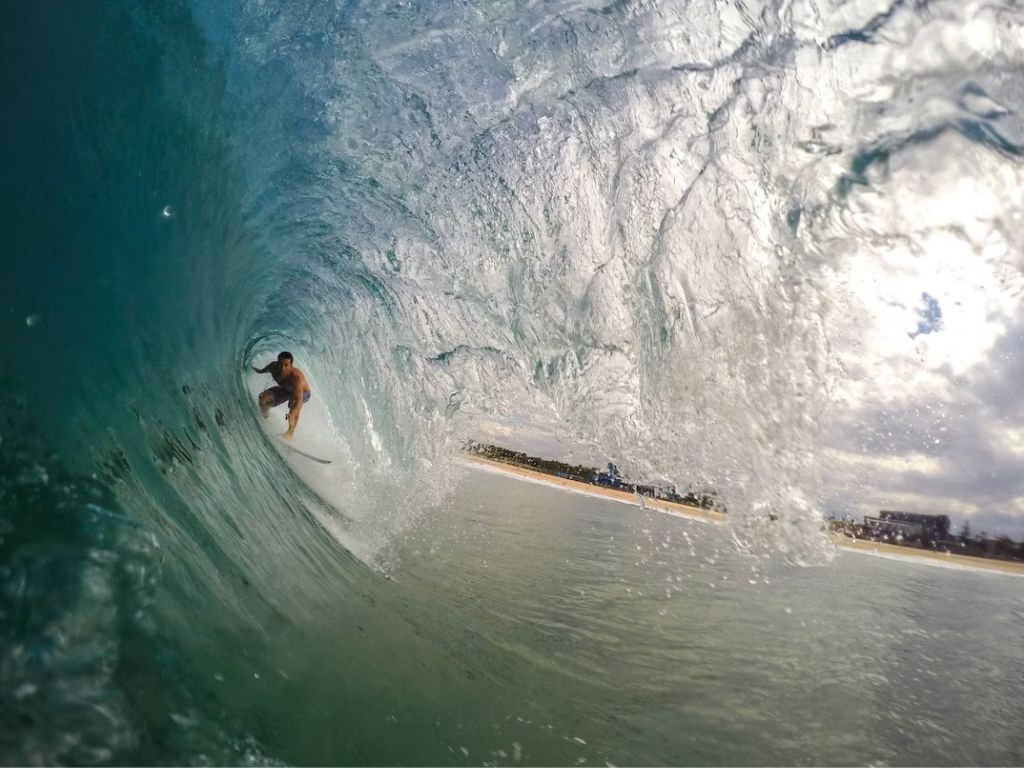Picture yourself paddling out into the open ocean, anticipation building as you prepare to catch the perfect wave. Sounds fun, doesn’t it? However, amidst the thrill, there is an essential aspect that you gotta be prepared for: the surf hold-down.
Managing a hold-down is not only about survival but also about regaining control and navigating through the force of the wave. By mastering the techniques and building the necessary skills, you can turn hold-downs into moments of empowerment and resilience.
Whether you’re a beginner looking to navigate through your first hold-down or an experienced surfer seeking to refine your skills, grab your surfboard and let’s get started!
What are wave hold-downs in surfing?
A hold-down is when you’re submerged underwater by the force of a breaking wave, preventing you from reaching the surface. It can vary in duration and intensity depending on wave size, power, and position. Hold-downs can involve single or multiple breath-holds underwater – which is quite taxing.
You can further subcategorize multiple holds into intermittent (you get a chance to catch your breath in between) and continuous (no chance of catching your breath for an extended time).
Several factors play a role in the occurrence of hold-downs. Wave size is a significant determinant, as larger waves have more energy and force. Additionally, powerful and steep-breaking waves are more likely to generate hold-downs.
Currents and the shape of the coastline can also influence the frequency and intensity of hold-downs. When assessing the potential for hold-downs in a particular surf spot, you should consider these factors.

1. How long can a wave hold you under?
Hold-downs generally range from a few seconds to more than 20 seconds. This ranges from 5-8 seconds for small waves and 12-15 seconds for head-high waves. Building lung capacity and practicing relaxation techniques can help extend the time you can hold your breath underwater.
However, it’s important to note that each hold-down is unique, and you should prioritize safety and surf within your skill level to minimize the risks associated with prolonged hold-downs.
A 2012 study suggests that surfers typically experience brief periods of continuous breath-holding lasting around 1.6 to 4.4 seconds at once after riding a wave.
2. How far down can a wave push you?
Generally, depending on environmental factors, a wave’s force can push you several or even tens of feet underwater. Small waves may push you down around 5-8 feet, while larger waves can displace surfers 10-15 feet below the surface.
However, these distances can vary due to wave conditions and individual circumstances. Surfing safely and being mindful of wave power is crucial in managing these situations.
3. How long should you be able to hold your breath?
In general, you should aim to develop a comfortable breath-hold duration of at least 30 seconds or more to navigate through hold-downs effectively. Building lung capacity and practicing breath-holding exercises can help improve your ability to withstand the demands of being underwater.
When managing hold-downs in surfing, the ability to hold your breath plays a crucial role.
While a 20-second breath-hold might seem sufficient for a single hold-down, it doesn’t accurately represent a real surf scenario. Factors like elevated pCO2 levels and the adrenaline of riding a wave can intensify the urge to breathe.
What to do when a wave breaks on you?
Finding yourself caught in a hold-down can be a daunting experience, but there are strategies you can use to navigate safely.
When a wave breaks on you, you must focus on breath control, maintaining buoyancy, and using the wave’s energy. This way, you can confidently enhance your ability to endure and appear from a hold-down.
1. Breath Control and Relaxation
During a hold-down, you must maintain control over your breath to optimize the oxygen supply and remain calm.
Deep breathing techniques, such as diaphragmatic breathing, can help conserve oxygen and prevent hyperventilation. Relaxation exercises, such as visualizing yourself in a calm environment, can also assist in managing anxiety and maintaining composure underwater.
2. Maintaining Buoyancy and Positioning
By positioning your body in a buoyant posture, you can minimize the impact of the wave’s force, thereby improving your chances of resurfacing.
Arch your back, extend your limbs, and relax to increase your buoyancy. Additionally, orienting yourself towards the surface and maintaining a streamlined position can help you ascend more efficiently when the wave’s energy subsidies.

3. Using the Wave’s Energy
Understanding and harnessing the wave’s energy can be advantageous during a hold-down.
As the wave breaks, its energy dissipates, creating a momentary lull. Utilize this brief period of reduced turbulence to propel yourself toward the surface. You can use the wave’s forward momentum to break free from the hold-down by kicking your legs and using your arms to swim upwards.
How to train for hold-downs?
Preparing for hold-downs requires a combination of physical conditioning and mental preparation.
1. Physical Conditioning and Fitness
Build Cardiovascular Endurance: It’ll help strengthen your heart and lungs, enhancing your ability to supply oxygen to your muscles and prolonging your breath-holding capabilities.
Practice Breath-Holding Exercises: Start by holding your Breath for short durations and gradually increase the time as your comfort level improves. Work on deep breathing techniques and relaxation exercises to remain calm and conserve oxygen during a hold-down.
Train Your Core Strength: It’ll assist in maintaining a buoyant posture and resisting a breaking wave’s force.
2. Mental Preparation and Awareness
Visualization and Mental Rehearsal: Visualizing yourself successfully navigating through a hold-down can enhance your mental preparedness. This mental rehearsal can build confidence and reduce anxiety when facing hold-down situations.
Meditation and Mindfulness: They improve your ability to stay present, manage stress, and maintain composure during intense situations.
Water Safety and Rescue Training: Familiarize yourself with water safety protocols and learn basic rescue techniques. Knowing how to assist others in hold-down situations can boost your confidence.
How to train for breath holds for surfing?
By incorporating breath-holding exercises into your routine and practicing in a simulated surfing environment, you can effectively enhance your ability to manage hold-downs.

1. Dryland Breath-Holding Exercises
Static Breath Holds: Take a deep breath and hold it for as long as comfortable, gradually increasing the duration. Focus on maintaining relaxation and composure during the breath hold.
Interval Training: Perform multiple repetitions of holding your Breath for a set duration, followed by a recovery period. This will mimic the intermittent nature of hold-downs in surfing.
CO2 Tolerance Training: It involves inducing a mild build-up of carbon dioxide in your body to simulate the real experience. It’s done by practicing breath holds after a series of intense exercises or by using specific breath-holding protocols designed to increase CO2 tolerance.
2. In-Water Training
Controlled Environments: Begin in calm, controlled water environments, such as a pool or a calm bay, to practice breath holds in a safe setting. Gradually expose yourself to more dynamic conditions.
Simulated Hold-Downs: This allows you to practice maintaining composure, breath control, and utilizing the wave’s energy to resurface.
Progression and Safety: Progress gradually in your in-water training, increasing the intensity and duration of simulated hold-downs as you become more comfortable and confident. Always prioritize safety and have a trained individual present during in-water training sessions.
Expert QnA
Q. How long will a 10-foot wave hold you down?
Generally, a hold-down caused by a 10-foot wave will last from a few seconds to around 20 seconds or longer. It’s important to understand that hold-down times are not standardized and can be unpredictable. Variables such as wave shape, power, and the surfer’s positioning play a role.
Q. How long can professional surfers hold their breath?
On average, professional surfers can hold their breath for around 3 to 4 minutes. Pro surfers possess exceptional breath-holding abilities due to their rigorous training and extensive experience in the water.
Q. Are there specific exercises to improve breath-holding for surfing?
It would be best to do static breath holds, CO2 tolerance exercises, and underwater swimming drills to improve your breath-holding. It is essential to train progressively and under safe conditions.
Q. How can I stay calm during a hold-down?
Techniques such as deep breathing, visualization, and positive self-talk can help maintain a calm and focused mindset. Building experience and familiarity with challenging surf conditions also contribute to calmness and confidence.
Q. Can wearing a surf leash help during a hold-down?
Generally, wearing a surf leash can provide added safety during a hold-down by keeping your surfboard close and preventing it from becoming a hazard. However, using the leash correctly and being mindful of entanglement risks is essential.
Q. What should I do if I experience a prolonged hold-down or struggle to surface?
If you experience a prolonged hold-down or have difficulty surfacing, remain calm and conserve energy. Stay focused on finding the surface and signaling for help if needed. Afterward, take the time to recover and evaluate the conditions before continuing to surf.





